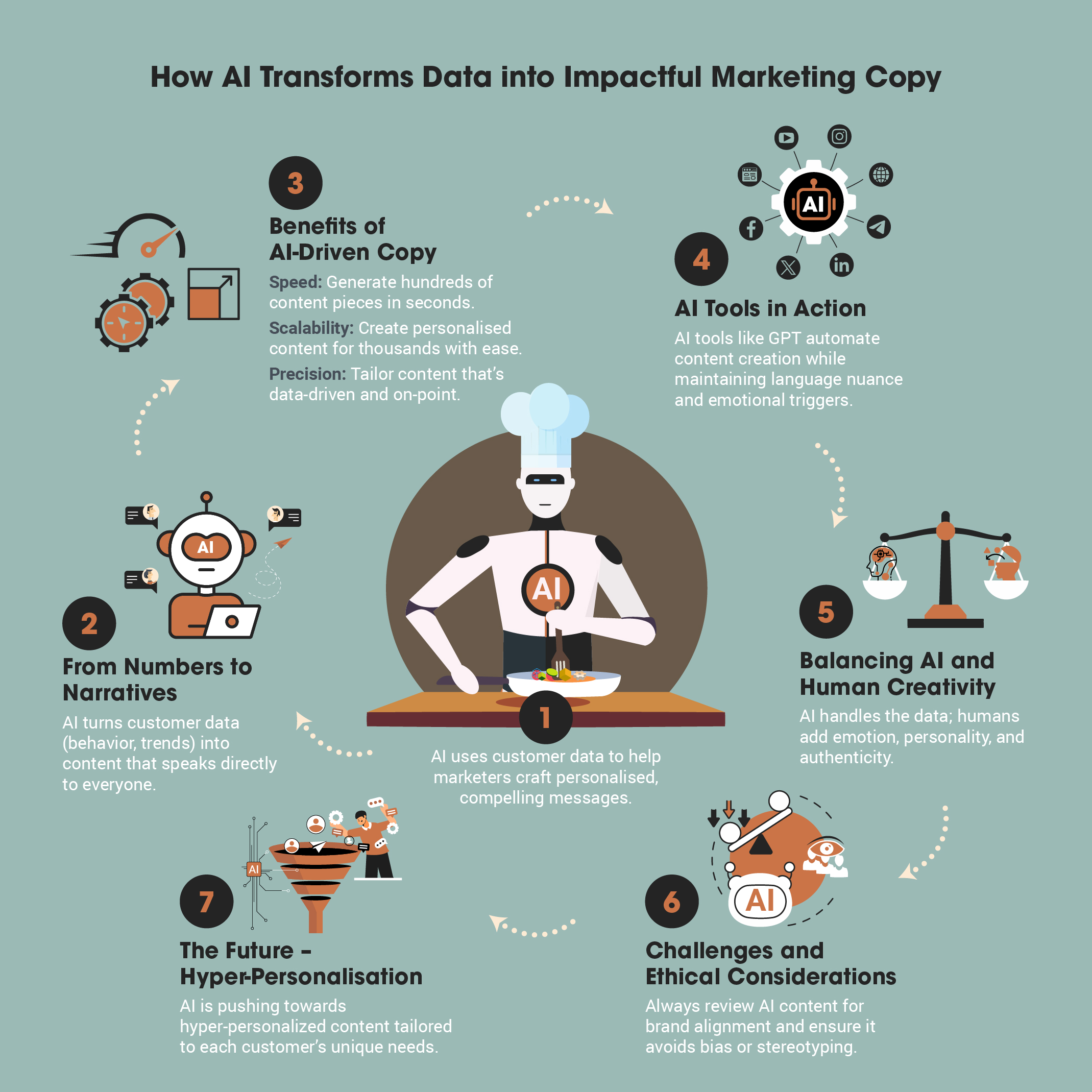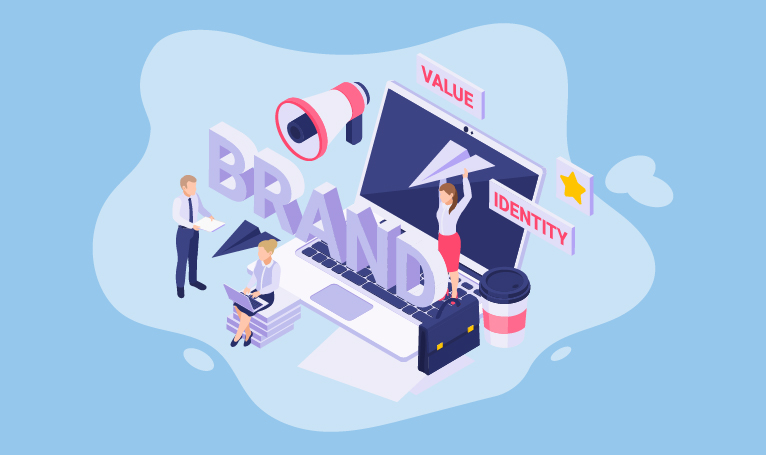Have you ever wondered how some brands know exactly what to say to grab your attention? It’s like they’re reading your mind, right? Well, there is a little secret behind this magic — artificial intelligence (AI) is the magician behind the curtain, turning raw data into the kind of marketing copy that makes you stop scrolling.
It’s not just about crunching numbers anymore; it’s about crafting stories that connect with you on a personal level. Let’s dive into how this tech magic works and how you can harness it to create a copy that sparkles.
The intersection of technology and creativity: An introduction to AI in marketing
Regardless of how best quality ingredients you have, you would always need a skilled chef to get a delicious meal prepared from those ingredients? That’s exactly what AI does in the world of marketing. It takes mountains of data — think numbers, trends, and customer behaviour — and turns them into something genuinely appetising: compelling marketing copy.
But don’t get it twisted — AI isn’t here to replace the creative genius of human writers. Instead, it’s like having a super-smart assistant who can quickly sift through data and spot patterns, helping you create the perfect message for your audience. Whether it’s a catchy headline or a personalised email, AI can take the grunt work out of data analysis so you can focus on what you do best: creating content that connects.
How AI Transforms Data into Copy: Step-by-Step Guide
In the age of AI-powered tools, understanding how AI transforms data into copy is essential for marketers, businesses, and content creators. Whether you're exploring AI copywriting, AI content generation, or want insights into AI content optimization, this guide breaks down the process into four clear phases.
Phase 1: Data Analysis
AI starts by processing large volumes of data — from customer insights to keyword trends and industry benchmarks. By analyzing structured and unstructured data, AI identifies patterns, preferences, and content gaps.
Example: AI tools like ChatGPT or Jasper analyze billions of data points to understand trending topics and search intent — a core strength in AI content generation.
Phase 2: Tone and Intent Recognition
Next, AI interprets the tone of voice, sentiment, and user intent based on the data it processes. Whether the goal is to sound professional, friendly, or persuasive, AI models are trained to match the appropriate tone with the intended audience.
✅This ensures that the content isn’t just informational but aligned with brand voice — a key benefit of advanced AI copywriting platforms.
Phase 3: Content Generation
Once the data is analyzed and tone is set, AI generates content tailored to specific needs — from blogs and product descriptions to emails and social media posts. AI models, powered by natural language processing (NLP), ensure the copy is coherent, engaging, and SEO-friendly.
✅ AI-generated content can be optimized with relevant keywords, formatting, and readability in mind, supporting AI SEO content strategies.
Phase 4: Optimization and Personalization
In the final phase, AI refines the content further by personalizing it for different audience segments. This includes:
- Keyword optimization for search engines
- A/B testing suggestions for better performance
- Personalized recommendations based on user behavior and preferences
Personalization elevates user engagement, making AI content not just generic but highly relevant — essential for effective AI content optimization.
From numbers to narratives: How AI transforms data into engaging content
Imagine you’re throwing a party. You could invite everyone you know, but wouldn’t it be better to send the perfect invitation to each guest? That’s what AI does with marketing copy. It transforms raw data — like who your customers are, what they’ve bought before, and what they’re likely to buy next — into a narrative that speaks directly to them.
AI tools can analyse data at lightning speed, turning it into insights about what your audience cares about. This isn’t just about demographics; it’s about understanding the motivations, fears, and passions that drive your customers. With this knowledge, AI helps you craft stories that aren’t just relevant — they’re irresistible.

Exploring AI tools: The future of automated content creation
Alright, so how does this all happen? The answer lies in the AI tools that are reshaping the marketing landscape. Tools like GPT (Generative Pre-trained Transformer) can generate everything from blog posts to social media updates in seconds. And here’s the best part — they’re getting better constantly.
These tools use algorithms that learn from vast amounts of content. They understand language nuances, tone, and even the emotional triggers that make us respond. So, whether you need a punchy ad or a thoughtful blog post, AI can whip it up in no time, leaving you free to focus on the big picture.
Benefits of AI-driven copy: Speed, Scalability, and Precision
Let’s talk about the benefits of harnessing AI to create a copy.
Speed
First off, AI-driven copy is really fast. Imagine generating hundreds of ad variations in the time it takes to make a cup of tea. That’s the speed we’re talking about.
Scalability
Next up is scalability. AI can handle the heavy lifting of whether you’re a small business or a global brand. Need to personalise content for thousands of customers? No problem. AI scales effortlessly, ensuring each copy is as polished as the last.
Precision
And finally, precision. AI isn’t just throwing words at a wall to see what sticks. It’s analysing data, learning from it, and homing in on what works. The result? Copy that’s well-written and strategically aligned with your business goals.
Balancing AI with human touch: Ensuring authenticity in automated content
But what about the human touch? If that’s the question in your mind, you’re right to be concerned. After all, marketing is about connecting with people, and nobody wants to read something that feels like a robot wrote it.
That’s why the best approach combines AI and human creativity. Think of AI as your co-writer. It can handle the heavy lifting, like generating ideas or drafting a copy. However, you’re still in the driver’s seat, adding the nuances, personality, and emotion only humans can provide. This way, your content remains authentic, relatable, resourceful, and data-driven.
Challenges and ethical considerations of AI in marketing
Of course, with great power comes great responsibility. AI in marketing isn’t without its challenges. For one, there’s the risk of over-reliance. If you lean too heavily on AI, you might have content lacking soul. Plus, there are ethical considerations. AI is only as good as the data it’s fed, and if that data is biased, your copy could inadvertently reinforce stereotypes or exclude certain groups.
That’s why it’s crucial to use AI thoughtfully. Keep your values at the forefront, and always review AI-generated content to confirm it aligns with your brand’s voice and principles. AI should enhance your creativity, not replace it.
The future of AI in copywriting: Trends and predictions for marketers
So, what’s the future like? AI will remain the copywriter’s ally if trends continue as they have been. One of the exciting trends is hyper-personalisation. AI will help marketers create custom content at scale. Think of sending a different message to each customer that satisfies his/her needs and preferences. It is easy with AI, and it is almost here.
Limitations of AI Content and The Need for Human Oversight
While AI copywriting and AI content generation are transforming how businesses create content, these tools still have limitations. Understanding when human intervention is necessary ensures that your content remains authentic, ethical, and aligned with your brand.
When is Human Oversight Essential?
- Brand Voice & Messaging: AI can sometimes produce generic or off-brand messaging, especially if not fine-tuned. Human editors ensure the tone matches brand guidelines and resonates with the target audience.
- Context & Nuance: AI might miss cultural nuances, emotional depth, or sensitive topics that require a human touch.
- Strategy Alignment: Humans are needed to align content with broader business strategies, campaign goals, or unique storytelling approaches.
Risks of Generic or Off-Brand Messaging
AI often pulls from vast datasets, which can lead to repetitive, impersonal, or even incorrect outputs. Relying solely on AI can risk:
- Diluted brand identity
- Inconsistent tone across content types
- Missed emotional connection with the audience
Ethical Considerations in AI Copywriting
Ethics in AI content generation is crucial. Concerns include:
- Bias in AI models that may reflect stereotypes
- Plagiarism risks if content is too derivative
- Readers should know when content is AI-generated versus human-created
Ensuring ethical use of AI requires transparency, originality checks, and responsible data handling.
Real-World Use Cases: How Brands Use AI Tools Effectively
Many startups and global brands successfully integrate AI into their content workflows. Here are examples:
1. Jasper AI for Marketing Campaigns
Startups use Jasper AI to quickly generate ad copies, blog drafts, and social media content — reducing turnaround times while maintaining SEO optimization.
2. HubSpot's AI Content Assistant
HubSpot leverages AI to help marketers draft blogs, emails, and landing pages while integrating personalization based on CRM data.
3. Grammarly's AI Writing Assistant
Grammarly Business uses AI not just for grammar checks but for tone adjustments and brand voice consistency — critical in professional communications.
4. Canva's Magic Write
Canva empowers designers with AI-powered copywriting tools for creating headlines, captions, and email copy directly within the design platform.
5. Netflix’s AI for Personalized Recommendations & Scripts
Netflix applies AI for personalizing recommendations and has even experimented with AI in scriptwriting to understand audience preferences.
Conclusion
AI isn’t here to replace human creativity — it’s here to supercharge it. By handling data-driven tasks, generating content drafts, and offering optimization insights, AI frees up time for humans to focus on strategy, storytelling, and authentic brand voice. But the best results come when human bring the creativity, strategy, and brand perspective, while AI handle the heavy lifting.
Explore AI with a mindset of collaboration, not substitution, human can unlock both productivity and originality.














